Experimental Study of Multi-Angle Effects of Micron-Silica Fume on Micro-Pore Structure and Macroscopic Mechanical Properties of Rock-like Material Based on NMR and SEM
Abstract
:1. Introduction
2. Material and Experiment
2.1. Material and Sample Preparation
2.2. Experimental Programme
2.2.1. Mechanical Property Testing
2.2.2. Micro-Pore Structure Testing
3. Pore Radius Dividing and Fractal Dimension Calculating
3.1. Pore Radius Dividing
3.2. Fractal Dimension Calculating
4. Results and Discussions
4.1. Effect of SF on Micro-Pore Structure
4.2. Effect of SF on Fractal Dimensions
4.3. Correlation Analysis between Mechanical Properties and Porosity and Fractal Dimension
5. Conclusions
- (1)
- Although under different conditions of WCR and SCR, the porosity of different radii showed a decreasing trend with the increase in SF. Among the porosity reduction rates, the macroporous porosity reduction rate was the largest, and the microporous porosity was the smallest;
- (2)
- When the incorporation of SF increased from 6% to 12%, the microscopic characteristics changed from a large number of pores, complex and disorderly morphological distribution, rough surface to a small number of pores, regular morphological distribution, flat surface, uniformity and denseness. The box fractal dimension also showed a gradually decreasing change law;
- (3)
- Microscopic pore structure played an important role in the influence of SF on mechanical properties. The compressive strength and tensile strength showed an increasing trend with the increase in SF. There was a negative correlation between the mechanical characteristic parameters and the fractal dimension, and the porosity parameters of different radii. Moreover, the compressive strength and tensile strength were in a good exponential relationship with porosity parameters of different radii.
Author Contributions
Funding
Institutional Review Board Statement
Informed Consent Statement
Data Availability Statement
Conflicts of Interest
Symbols and Notations
| WCR | Water–cement ratio |
| SCR | Sand–cement ratio |
| ADR | Admixtures |
| SF | Silica Fume |
| NMR | Nuclear Magnetic Resonance |
| SEM | Scanning Electron Microscope |
| MIP | Mercury Injection Experiment |
| CT | Computed Tomography |
| 3CaO·SiO2 | |
| 2CaO·SiO2 | |
| Ca(OH)2 | |
| H2O | |
| 3CaO·SiO2·3H2O |
References
- Jiang, C.; Guo, W.; Chen, H.; Zhu, Y.; Jin, C. Effect of filler type and content on mechanical properties and microstructure of sand concrete made with superfine waste sand. Constr. Build. Mater. 2018, 192, 442–449. [Google Scholar] [CrossRef]
- Diambra, A.; Festugato, L.; Ibraim, E.; da Silva, A.P.; Consoli, N.C. Modelling tensile/compressive strength ratio of artificially cemented clean sand. Soils and foundations. Soils Found. 2018, 58, 199–211. [Google Scholar] [CrossRef]
- Jueyendah, S.; Lezgy-Nazargah, M.; Eskandari-Naddaf, H.; Emamian, S. Predicting the mechanical properties of cement mortar using the support vector machine approach. Constr. Build. Mater. 2021, 291, 123396. [Google Scholar] [CrossRef]
- Chuta, E.; Colin, J.; Jeong, J. The impact of the water-to-cement ratio on the surface morphology of cementitious materials. J. Build. Eng. 2020, 32, 101716. [Google Scholar] [CrossRef]
- Siddique, R. Utilization of silica fume in concrete: Review of hardened properties. Resour. Conserv. Recycl. 2011, 55, 923–932. [Google Scholar] [CrossRef]
- Karthik, D.; Nirmalkumar, K.; Priyadharshini, R. Characteristic assessment of self-compacting concrete with supplementary cementitious materials. Constr. Build. Mater. 2021, 297, 123845. [Google Scholar] [CrossRef]
- Liu, H.; Luo, G.; Wang, L.; Wang, W.; Li, W.; Gong, Y. Laboratory Evaluation of Eco-Friendly Pervious Concrete Pavement Material Containing Silica Fume. Appl. Sci. 2019, 9, 73. [Google Scholar] [CrossRef] [Green Version]
- Lu, Z.; Feng, Z.-G.; Yao, D.; Li, X.; Ji, H. Freeze-thaw resistance of Ultra-High performance concrete: Dependence on concrete composition. Constr. Build. Mater. 2021, 293, 123523. [Google Scholar] [CrossRef]
- Elrahman, M.A.; Sikora, P.; Chung, S.-Y.; Stephan, D. The performance of ultra-lightweight foamed concrete incorporating nanosilica. Arch. Civ. Mech. Eng. 2021, 21, 79. [Google Scholar] [CrossRef]
- Wang, X.; Gong, C.; Lei, J.; Dai, J.; Lu, L.; Cheng, X. Effect of silica fume and nano-silica on hydration behavior and mechanism of high sulfate resistance Portland cement. Constr. Build. Mater. 2021, 279, 122481. [Google Scholar] [CrossRef]
- Liu, R.; Chi, Y.; Jiang, Q.; Meng, X.; Wu, K.; Li, S. Physical and mechanical properties of pervious concrete with multi-admixtures. Mag. Concr. Res. 2021, 73, 448–463. [Google Scholar] [CrossRef]
- Lü, Q.; Qiu, Q.; Zheng, J.; Wang, J.; Zeng, Q. Fractal dimension of concrete incorporating silica fume and its correlations to pore structure, strength and permeability. Constr. Build. Mater. 2019, 228, 116986. [Google Scholar] [CrossRef]
- Forquin, P.; Arias, A.; Zaera, R. Role of porosity in controlling the mechanical and impact behaviours of cement-based materials. Int. J. Impact Eng. 2008, 35, 133–146. [Google Scholar] [CrossRef] [Green Version]
- Shi, C.; Wang, D.; Wu, L.; Wu, Z. The hydration and microstructure of ultra high-strength concrete with cement–silica fume–slag binder. Cem. Concr. Compos. 2015, 61, 44–52. [Google Scholar] [CrossRef]
- Tian, G.; Deng, H.; Xiao, Y. Correlation Analysis between Microscopic Pore Parameters and Macroscopic Mechanical Properties of Rock-like Materials from the Perspective of Water-Cement Ratio and Sand-Cement Ratio. Materials 2022, 15, 2632. [Google Scholar] [CrossRef] [PubMed]
- Deng, H.; Tian, G.; Yu, S.; Jiang, Z.; Zhong, Z.; Zhang, Y. Research on Strength Prediction Model of Sand-like Material Based on Nuclear Magnetic Resonance and Fractal Theory. Appl. Sci. 2020, 10, 6601. [Google Scholar] [CrossRef]
- Yu, S.; Deng, H.; Tian, G.; Ke, Y. Research on dynamic compressive characteristics of rock-like material considering the influence of crack angles and freeze–thaw cycles. Arab. J. Geosci. 2022, 15, 248. [Google Scholar] [CrossRef]
- Yu, S.; Ke, Y.; Deng, H.; Tian, G.; Deng, J. Experimental Investigation of Porous and Mechanical Characteristics of Single-Crack Rock-like Material under Freeze-Thaw Weathering. Minerals 2021, 11, 1318. [Google Scholar] [CrossRef]
- Deng, H.; Yu, S.; Deng, J. Damage Characteristics of Sandstone Subjected to Coupled Effect of Freezing-Thawing Cycles and Acid Environment. Adv. Civ. Eng. 2018, 2018, 3560780. [Google Scholar] [CrossRef] [Green Version]
- Zhang, J.; Deng, H.; Deng, J.; Gao, R. Fractal Analysis of Pore Structure Development of Sandstone: A Nuclear Magnetic Resonance Investigation. IEEE Access 2019, 7, 47282–47293. [Google Scholar] [CrossRef]
- Li, J.; Liu, H.; Ai, K.; Zhu, L. An NMR-Based Experimental Study on the Pore Structure of the Hydration Process of Mine Filling Slurry. Adv. Civ. Eng. 2018, 2018, 4720356. [Google Scholar] [CrossRef] [Green Version]
- Li, J.; Zhou, K.; Liu, W.; Zhang, Y. Analysis of the effect of freeze–thaw cycles on the degradation of mechanical parameters and slope stability. Bull. Eng. Geol. Environ. 2018, 77, 573–580. [Google Scholar] [CrossRef]
- Li, J.; Kaunda, R.B.; Zhou, K. Experimental investigations on the effects of ambient freeze-thaw cycling on dynamic properties and rock pore structure deterioration of sandstone. Cold Reg. Sci. Technol. 2018, 154, 133–141. [Google Scholar] [CrossRef]
- Li, J.; Zhou, K.-P.; Liu, W.-J.; Deng, H.-W. NMR research on deterioration characteristics of microscopic structure of sandstones in freeze–thaw cycles. Trans. Nonferrous Met. Soc. China 2016, 26, 2997–3003. [Google Scholar] [CrossRef]
- Bu, J.; Tian, Z. Relationship between pore structure and compressive strength of concrete: Experiments and statistical modeling. Sadhana 2016, 41, 337–344. [Google Scholar] [CrossRef] [Green Version]
- Zarnaghi, V.N.; Fouroghi-Asl, A.; Nourani, V.; Ma, H. On the pore structures of lightweight self-compacting concrete containing silica fume. Constr. Build. Mater. 2018, 193, 557–564. [Google Scholar] [CrossRef]
- Hu, J.; Ren, Q.; Yang, D.; Ma, S.; Luo, Z. Cross-scale characteristics of backfill material using NMR and fractal theory. Trans. Nonferrous Met. Soc. China 2020, 30, 347–1363. [Google Scholar] [CrossRef]
- Zhang, L.; Zhou, J. Fractal characteristics of pore structure of hardened cement paste prepared by pressurized compact molding. Constr. Build. Mater. 2020, 259, 119856. [Google Scholar] [CrossRef]
- Hazra, B.; Wood, D.A.; Kumar, S.; Saha, S.; Dutta, S.; Kumari, P.; Singh, A.K. Fractal disposition, porosity characterization and relationships to thermal maturity for the Lower Permian Raniganj basin shales, India. J. Nat. Gas Sci. Eng. 2018, 59, 452–465. [Google Scholar] [CrossRef]
- SL/T 264-2020; Rock Test Regulations for Water Conservancy and Hydropower Engineering. People‘s Republic of China Ministry of Water Resources: Beijing, China, 2020. (In Chinese)
- Valckenborg, R.M.E.; Pel, L.; Hazrati, K.; Kopinga, K.; Marchand, J. Pore water distribution in mortar during drying as determined by NMR. Mater. Struture 2001, 34, 599–604. [Google Scholar] [CrossRef]
- Muller, A.C.; Scrivener, K.L.; Gajewicz, A.M.; McDonald, P.J. Densification of C–S–H Measured by1H NMR Relaxometry. J. Phys. Chem. C 2013, 117, 403–412. [Google Scholar] [CrossRef] [Green Version]
- Yan, J.; Wen, D.; Li, Z.G. The quantitative evaluation method of low permeable sandstone pore structure based on nuclear magnetic resonance (NMR) logging. Chin. J. Geophys. 2016, 59, 1543–1552. [Google Scholar]
- Bayraktar, O.Y.; Soylemez, H.; Kaplan, G.; Benli, A.; Gencel, O.; Turkoglu, M. Effect of cement dosage and waste tire rubber on the mechanical, transport and abrasion characteristics of foam concretes subjected to H2SO4 and freeze–thaw. Constr. Build. Mater. 2021, 302, 124229. [Google Scholar] [CrossRef]
- Papadakis, V.G. Effect of supplementary cementing materials onconcrete resistance against carbonation and chloride ingress. Cem. Concr. Res. 2000, 30, 291–299. [Google Scholar] [CrossRef]
- Wang, X.; Lee, H. Modeling the hydration of concrete incorporating fly ash or slag. Cem. Concr. Res. 2010, 40, 984–996. [Google Scholar] [CrossRef]
- Copetti, C.M.; Borges, P.M.; Squiavon, J.Z.; da Silva, S.R.; Andrade, J.J.D.O. Evaluation of tire rubber surface pre-treatment and silica fume on physicalmechanical behavior and microstructural properties of concrete. J. Clean. Prod. 2020, 256, 120670. [Google Scholar] [CrossRef]
- Zhang, B.; Li, S. Determination of the surface fractal dimension for porous media by mercury porosimetry. Ind. Eng. Chem. Res. 1995, 34, 1383–1386. [Google Scholar] [CrossRef]
- Ji, Y.; Sun, Z.; Jiang, X.; Liu, Y.; Shui, L.; Chen, C. Fractal characterization on pore structure and analysis of flfluidity and bleeding of fresh cement paste based on 1H low-fifield NMR. Constr. Build. Mater. 2017, 140, 445–453. [Google Scholar] [CrossRef]
- Liu, L.; Fang, Z.; Qi, C.; Zhang, B.; Guo, L.; Song, K.I. Experimental investigation on the relationship between pore characteristics and unconfifined compressive strength of cemented paste backfifill. Constr. Build. Mater. 2018, 179, 254–264. [Google Scholar] [CrossRef]
- Pfeifer, P.; Avnir, D. Chemistry in noninteger dimensions between two and three. I. Fractal theory of heterogeneous surfaces. J. Chem. Phys. 1983, 79, 3558–3565. [Google Scholar] [CrossRef]
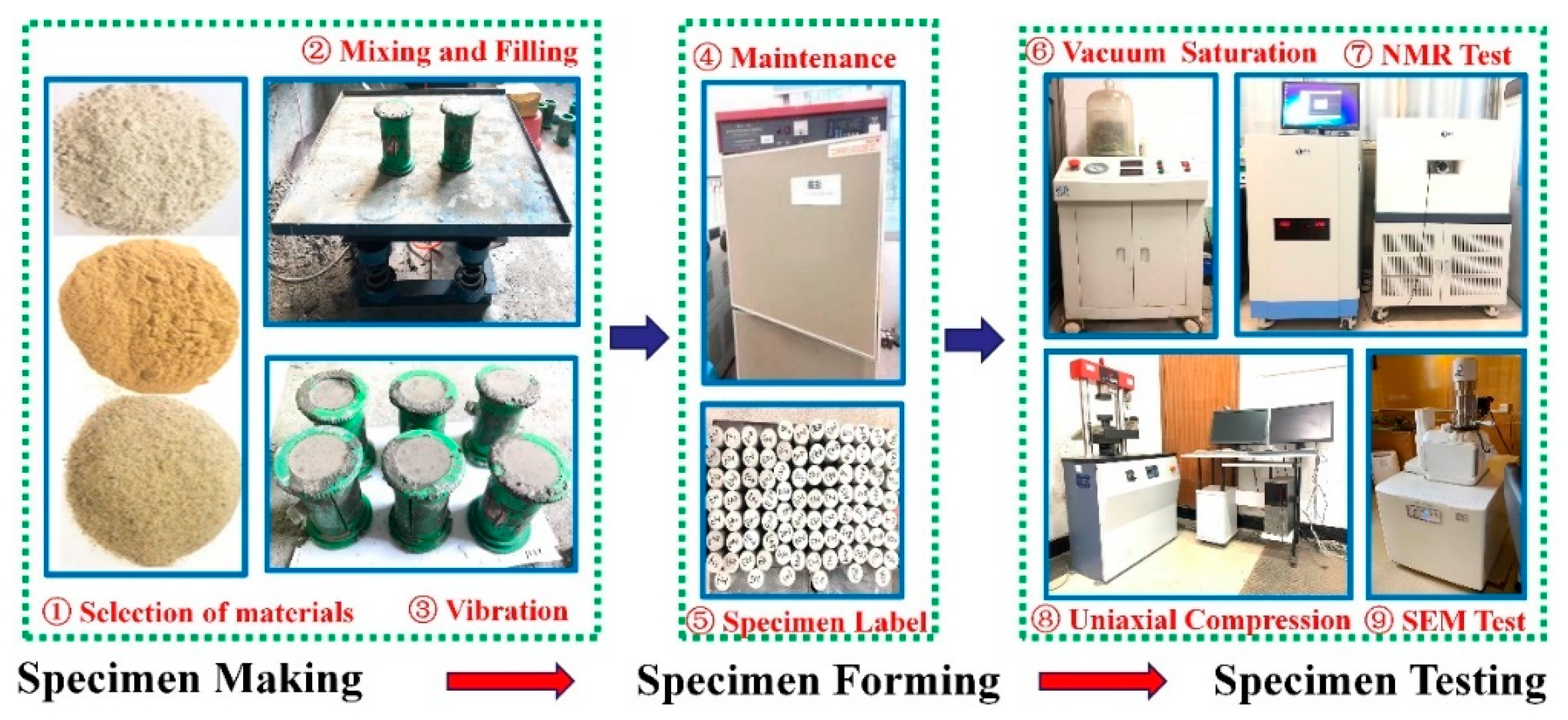
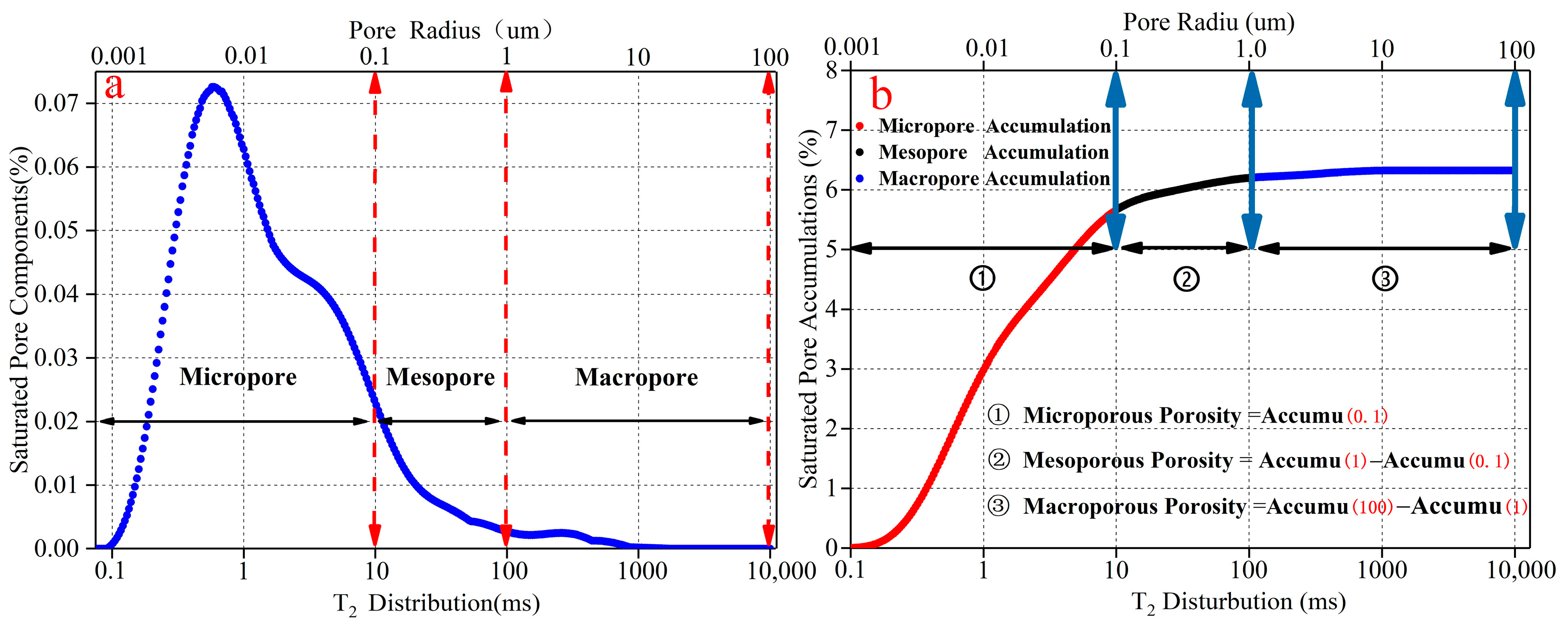

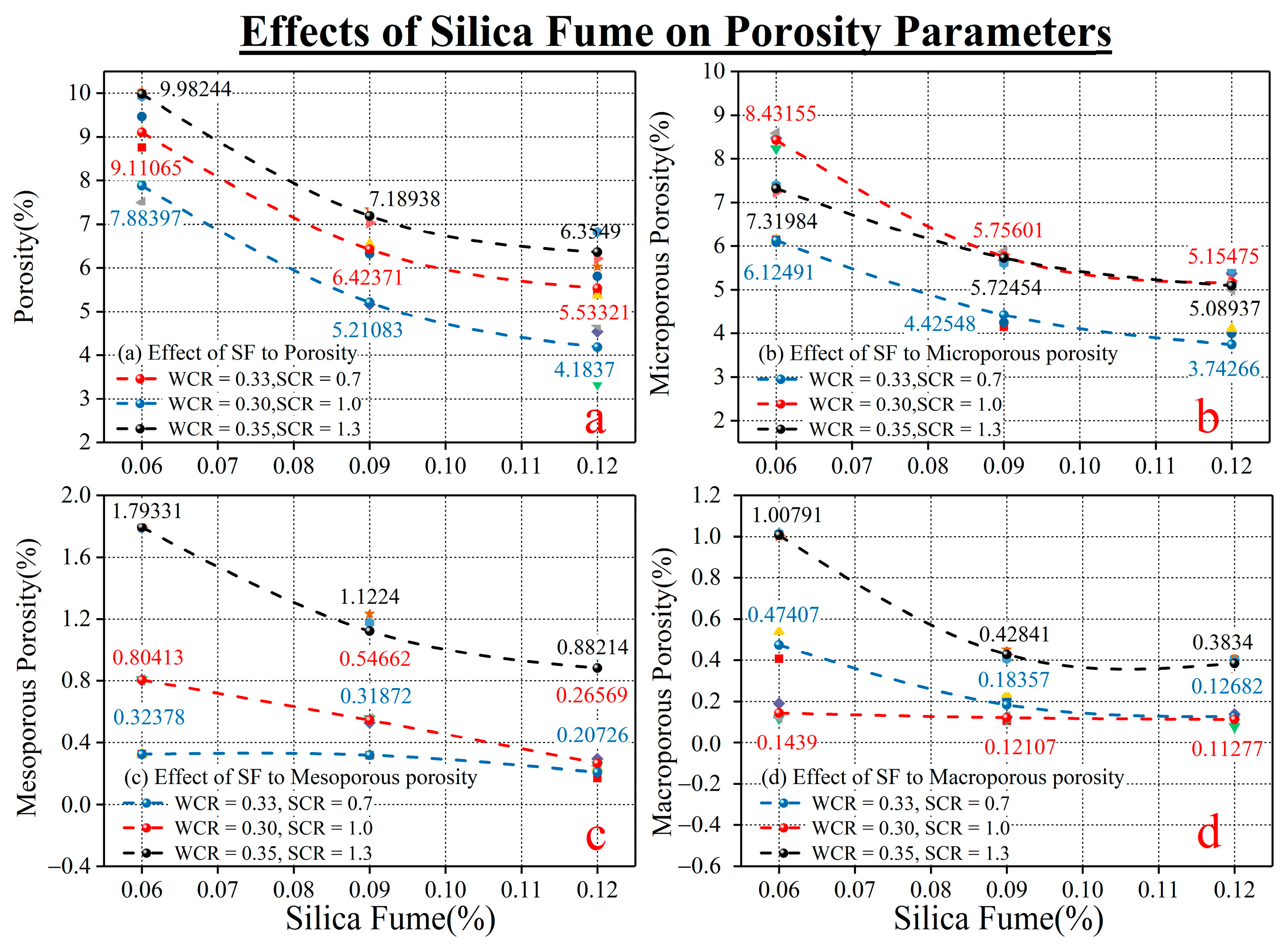

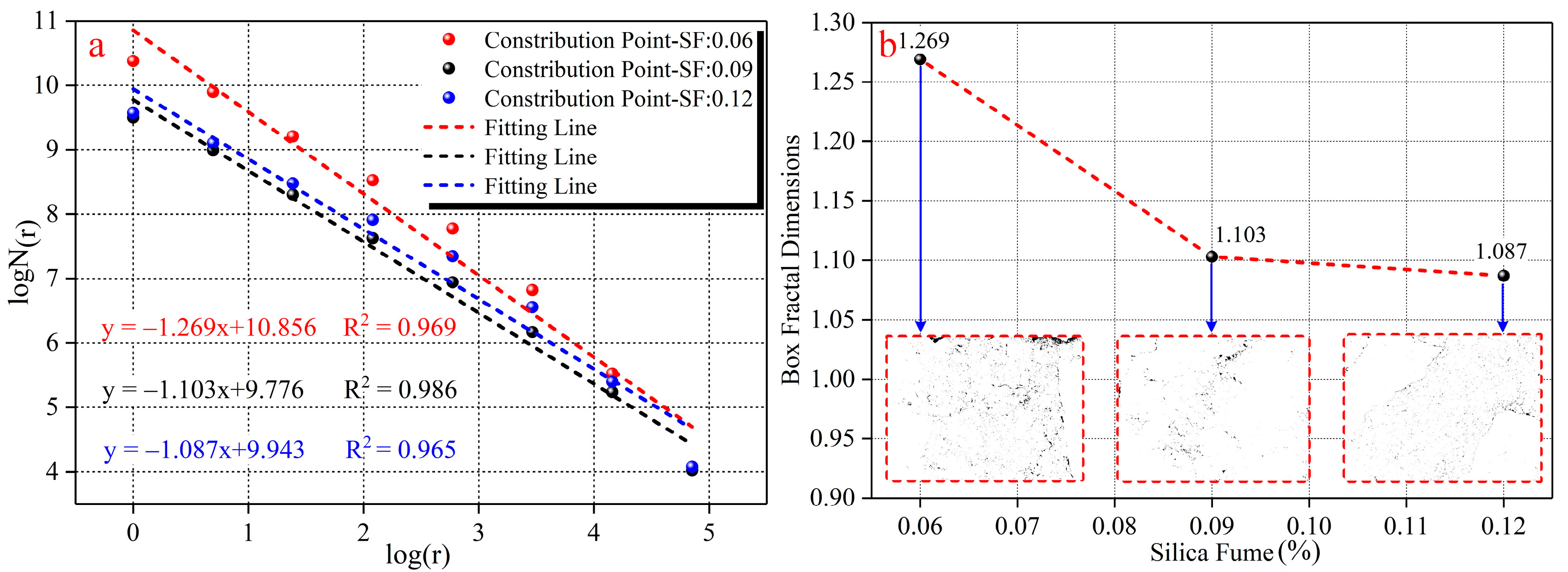
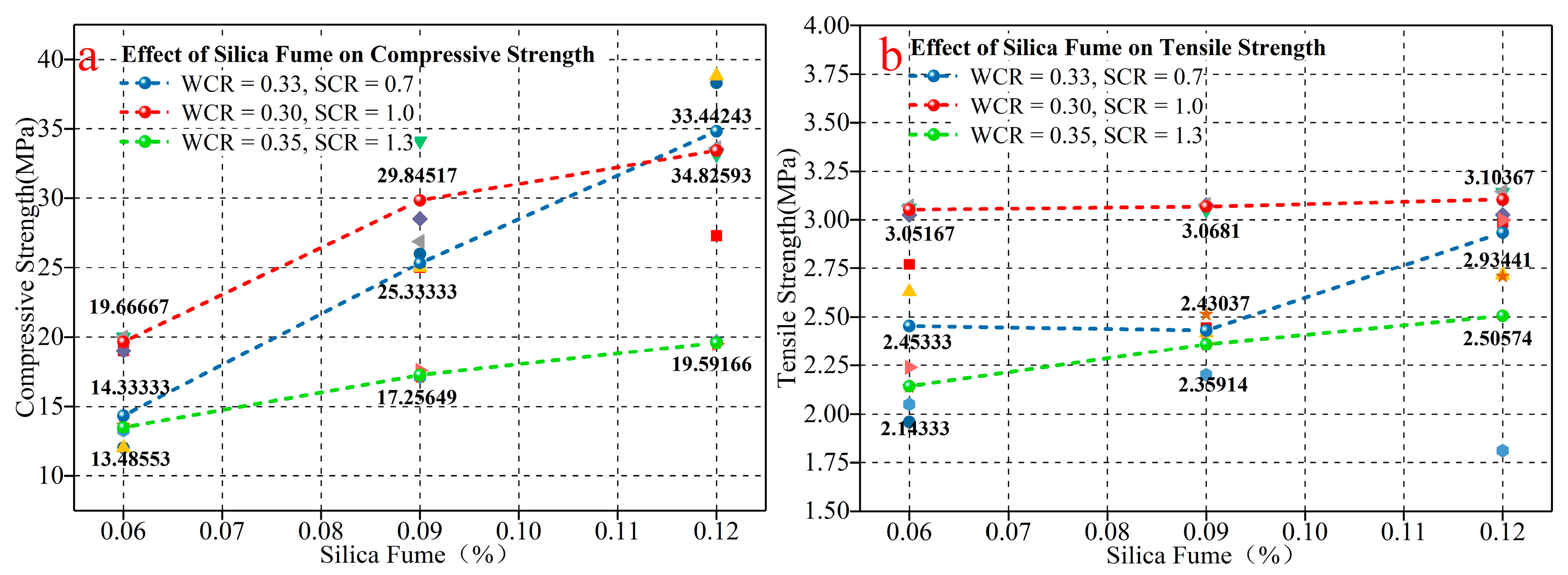


| Chemical Composition | 3CaO·SiO2 | 2CaO·SiO2 | 3CaO·Al2O3 | 4CaO·Al2O3·Fe2O3 |
|---|---|---|---|---|
| Content | 52.8% | 20.7% | 11.5% | 8.8% |
| Material | Traits | Main Ingredients | Particle Size | Density (g/cm3) |
|---|---|---|---|---|
| Quartz sand | Yellow and white particles | quartz > 99% | 0.5–1.0 mm | 1.49 |
| Naphthalene water reducer | Brown yellow powder | β-Naphthal-enesulfonate sodium formaldehyde condensate | - | - |
| Material | Traits | Particle Size | Density (g/cm3) | Specific Surface Area (m2/g) | Component Content | ||||||
|---|---|---|---|---|---|---|---|---|---|---|---|
| CaO | SiO2 | Al2O3 | CuO | MgO | Na2O | K2O | |||||
| Silica Fume | White powder | 1 μm | 2.2–2.6 | 80 | 0.1 | 99.2 | 0.2 | 0.1 | 0.2 | 0.1 | 0.2 |
| Experimental Schemes | Experimental Factors | ||
|---|---|---|---|
| SF(SF/WCR) | WCR | SCR | |
| 1 | 6% | 0.3 | 1 |
| 9% | |||
| 12% | |||
| 2 | 6% | 0.33 | 0.7 |
| 9% | |||
| 12% | |||
| 3 | 6% | 0.35 | 1.3 |
| 9% | |||
| 12% | |||
| Porosity Type | Silica Fume | Reduction Rate | The Average of Reduction Rate | ||
|---|---|---|---|---|---|
| 6% | 9% | 12% | |||
| Microporous porosity | 6.12491 | 4.42548 | 3.74266 | 38.89% | 36.01% |
| 8.43155 | 5.75601 | 5.15475 | 38.86% | ||
| 7.31984 | 5.72454 | 5.08937 | 30.47% | ||
| Mesoporous porosity | 0.32378 | 0.31872 | 0.20726 | 35.99% | 51.25% |
| 0.80413 | 0.54662 | 0.26569 | 66.96% | ||
| 1.79331 | 1.1224 | 0.88214 | 50.81% | ||
| Macroporous porosity | 0.47407 | 0.18357 | 0.12682 | 73.25% | 52.28% |
| 0.1439 | 0.12107 | 0.11277 | 21.63% | ||
| 1.00791 | 0.42841 | 0.3834 | 61.96% | ||
| Mechanical Property | Silica Fume | Increase Rate | The Average of Increase Rate | ||
|---|---|---|---|---|---|
| 6% | 9% | 12% | |||
| Compressive strength (MPa) | 19.6667 | 29.84517 | 34.82593 | 77.08% | 85.22% |
| 14.33333 | 25.3333 | 33.44243 | 133.32% | ||
| 13.48553 | 17.25649 | 19.59166 | 45.28% | ||
| Tensile strength (MPa) | 3.05167 | 3.0681 | 3.10367 | 1.70% | 12.74% |
| 2.45333 | 2.43037 | 2.93441 | 19.61% | ||
| 2.14333 | 2.35914 | 2.50574 | 16.91% | ||
| Parameter Type | Silica Fume | |
|---|---|---|
| Compressive Strength (MPa) | Tensile Strength (MPa) | |
| Porosity | −0.9339 | −0.8962 |
| Microporous Porosity | −0.9242 | −0.8621 |
| Mesoporous Porosity | −0.9064 | −0.8937 |
| Macroporous Porosity | −0.6778 | −0.7985 |
Publisher’s Note: MDPI stays neutral with regard to jurisdictional claims in published maps and institutional affiliations. |
© 2022 by the authors. Licensee MDPI, Basel, Switzerland. This article is an open access article distributed under the terms and conditions of the Creative Commons Attribution (CC BY) license (https://creativecommons.org/licenses/by/4.0/).
Share and Cite
Tian, G.; Deng, H.; Xiao, Y.; Yu, S. Experimental Study of Multi-Angle Effects of Micron-Silica Fume on Micro-Pore Structure and Macroscopic Mechanical Properties of Rock-like Material Based on NMR and SEM. Materials 2022, 15, 3388. https://doi.org/10.3390/ma15093388
Tian G, Deng H, Xiao Y, Yu S. Experimental Study of Multi-Angle Effects of Micron-Silica Fume on Micro-Pore Structure and Macroscopic Mechanical Properties of Rock-like Material Based on NMR and SEM. Materials. 2022; 15(9):3388. https://doi.org/10.3390/ma15093388
Chicago/Turabian StyleTian, Guanglin, Hongwei Deng, Yigai Xiao, and Songtao Yu. 2022. "Experimental Study of Multi-Angle Effects of Micron-Silica Fume on Micro-Pore Structure and Macroscopic Mechanical Properties of Rock-like Material Based on NMR and SEM" Materials 15, no. 9: 3388. https://doi.org/10.3390/ma15093388
APA StyleTian, G., Deng, H., Xiao, Y., & Yu, S. (2022). Experimental Study of Multi-Angle Effects of Micron-Silica Fume on Micro-Pore Structure and Macroscopic Mechanical Properties of Rock-like Material Based on NMR and SEM. Materials, 15(9), 3388. https://doi.org/10.3390/ma15093388





